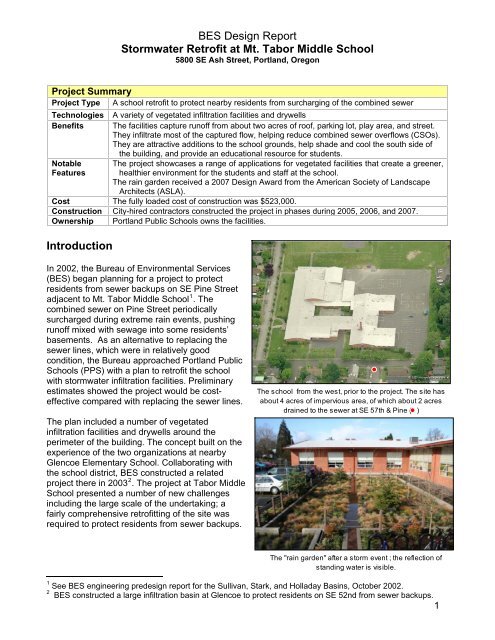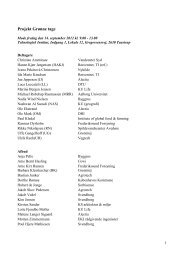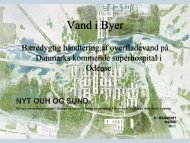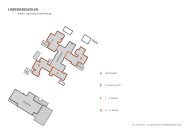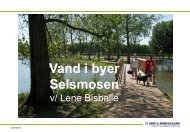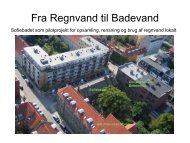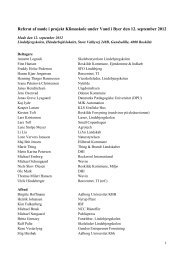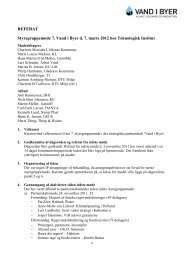Environmental Services Design Report - Vand i Byer
Environmental Services Design Report - Vand i Byer
Environmental Services Design Report - Vand i Byer
You also want an ePaper? Increase the reach of your titles
YUMPU automatically turns print PDFs into web optimized ePapers that Google loves.
BES <strong>Design</strong> <strong>Report</strong>Stormwater Retrofit at Mt. Tabor Middle School5800 SE Ash Street, Portland, OregonProject SummaryProject Type A school retrofit to protect nearby residents from surcharging of the combined sewerTechnologies A variety of vegetated infiltration facilities and drywellsBenefits The facilities capture runoff from about two acres of roof, parking lot, play area, and street.They infiltrate most of the captured flow, helping reduce combined sewer overflows (CSOs).They are attractive additions to the school grounds, help shade and cool the south side ofthe building, and provide an educational resource for students.Notable The project showcases a range of applications for vegetated facilities that create a greener,Features healthier environment for the students and staff at the school.The rain garden received a 2007 <strong>Design</strong> Award from the American Society of LandscapeArchitects (ASLA).Cost The fully loaded cost of construction was $523,000.Construction City-hired contractors constructed the project in phases during 2005, 2006, and 2007.Ownership Portland Public Schools owns the facilities.IntroductionIn 2002, the Bureau of <strong>Environmental</strong> <strong>Services</strong>(BES) began planning for a project to protectresidents from sewer backups on SE Pine Streetadjacent to Mt. Tabor Middle School 1 . Thecombined sewer on Pine Street periodicallysurcharged during extreme rain events, pushingrunoff mixed with sewage into some residents’basements. As an alternative to replacing thesewer lines, which were in relatively goodcondition, the Bureau approached Portland PublicSchools (PPS) with a plan to retrofit the schoolwith stormwater infiltration facilities. Preliminaryestimates showed the project would be costeffectivecompared with replacing the sewer lines.The plan included a number of vegetatedinfiltration facilities and drywells around theperimeter of the building. The concept built on theexperience of the two organizations at nearbyGlencoe Elementary School. Collaborating withthe school district, BES constructed a relatedproject there in 2003 2 . The project at Tabor MiddleSchool presented a number of new challengesincluding the large scale of the undertaking; afairly comprehensive retrofitting of the site wasrequired to protect residents from sewer backups.The school from the west, prior to the project. The site hasabout 4 acres of impervious area, of which about 2 acresdrained to the sewer at SE 57th & Pine ( )The "rain garden" after a storm event ; the reflection ofstanding water is visible.1 See BES engineering predesign report for the Sullivan, Stark, and Holladay Basins, October 2002.2 BES constructed a large infiltration basin at Glencoe to protect residents on SE 52nd from sewer backups.1
Depth to groundwaterA draft regional groundwater map by the United StatesGeological Survey reports the estimated depth to highgroundwater as more than 100 feet below grade.Groundwater was not encountered when BES installed a 30-foot stormwater sump at SE 57th and Pine in January 2005.In July 2005, city staff conducted a geotechnical fieldevaluation. The evaluation included hand-augering to adepth of about 14 feet at two locations on the east side ofthe school where the draft plan called for clusters ofdrywells. Groundwater was encountered at 15 feet belowgrade in the hole near the southeast corner of the building.As a result, the southern pair of drywells planned for thatlocation were moved to the north, in the direction of themore favorable conditions found in the vicinity of the secondauger hole. (During construction the plan to construct thesouthern pair of drywells was abandoned when groundwaterwas encountered at the modified location.)Field evaluation of soil textureCity geotechnical staff characterized soil texture during theJuly 2005 field evaluation. A mechanical 12-inch stem augerwas used to dig ten 4-foot deep holes around the buildingperimeter. In two of the holes, a hand auger was used toobtain samples to about 15 feet below grade (see also thesection “Depth to groundwater”). The soils at the samplepoints on the north and south sides of the school werecharacterized as silty sands. At the north end of the eastside of the building, the soils consisted of dry, poorly sortedsand with silt and gravel, similar to the material found duringconstruction of the sump at SE 57th and Pine in 2005. Nearthe southeast corner of the building the soil profile wassubstantially different than elsewhere at the site: a surfacelayer of silty material was underlain by what appeared to befine-grained fill, including burnt wood and brick fragments.That layer was in turn underlain by mottled bluish-greyclayey silt lower in the profile.Shallow infiltration testsBES staff conducted shallow infiltration tests as part of theJuly 2005 field evaluation. Seven of the 4-foot deep pits weretested. The tested rates ranged from less than .6 in/hr togreater than 5 in/hr. The highest rates were at the north endof the east side of the building where the soils were poorlysorted sands. The lowest rates were in the silty soils on thesouth side of the school in the vicinity of the rain garden andthe parking lot swale.Augering holes for soil evaluationsand infiltration testsAn infiltration testGeotechnical evaluation at the SEcorner of the schoolLocating existing storm lines along theperimeter of the building3
Opportunities and ConstraintsGeotechnical conditionsInformation obtained during the planning phase about the shallowsoils – soil texture and infiltration rates – did not alter plans forvegetated infiltration facilities. Although the surface soils arerelatively silty and in some cases yielded low infiltration rateswhen tested, other BES vegetated infiltration systems in thevicinity have performed well in similar conditions. Informationabout deeper conditions – soil texture and groundwater levels –led to changes in the planned location of the southern pair ofdrywells. The plan for the pair then was abandoned duringconstruction when groundwater was encountered at the newlocation.The existing collection system and foundationThe building has external downspouts which alloweddisconnections to planters. It also has stormwater collection linesaround the perimeter which allowed facilities such as the raingarden and drywells requiring overflow connections. The schoolfoundation has a shallow crawl space, not a full basement, whichmeant that vegetated infiltration systems could be located closerto the edge of the building than if there had been a basement.TopographyWhat originally appeared to be a major constraint on the southside of the building – the fact that a large expanse of asphaltdrains toward the building – was turned into an asset for thedesign. By reworking the configuration of the parking lot, enoughspace was created along the building edge for a large planter(the “rain garden”) that is very efficient as far as the catchmentarea it manages. The facility drains roughly 10,000 ft 2 of roof andalmost 20,000 ft 2 of asphalt.Inefficient configuration of the old parking lotA simple reworking of the parking lot configuration – shorterparking stall lengths and narrower drive aisles – provided ampleroom for the rain garden and the swale with the loss of just acouple of spaces. The new aisles are 21 feet wide; the parkingstalls are 9 feet wide and 17 feet long, which is above minimumstandards.Value of an aesthetic improvement for the schoolThe project was supported by the school community in partbecause the addition of the rain garden and the parking lot swalewas an opportunity to make the school a greener, healthier, morevisually appealing environment for the students and staff. Thetwo facilities replace expanses of asphalt, helping to cool theparking lot and the classrooms facing the rain garden. They alsohelp organize and improve the safety of the entrance on thesouth side of the school.Construction of the curb extensionon SE 57thCompletion of rain garden walls, prior topreparation of the soilsConstruction of the parking lot swaleThe parking lot swale after placement of10" of imported soil, foot compaction, andfinal grading . The facility has twopedestrian crossings (with trench drains)and two main check dams withadjustable weirs.4
Constraints due to site usesThe design team considered the possibility of constructing facilities in the school’s internal courtyardas well as along the west side of the school. Physical site constraints in those locations precludedfurther consideration. The original concept called for additional vegetated facilities on the east side ofthe school. A more detailed evaluation of site uses ultimately led to construction of drywells thererather than vegetated systems; space requirements for hard-surface games left little room forincorporating vegetated systems.Overview of the FacilitiesFacility ComparisonFacility Catchment Facility Ponding Internal Storm OverflowFacility Type (ft 2 of IA d ) Area (ft 2 ) Depth (ft) Volume (ft 3 ) Peak (ft 3 ) e DestinationRain garden Planter 28,500 1,850 0.66 1,200 1,140 sewerParking Lot Swale Swale 12,000 1,400 0.66 800 480 street/sump fDownspout planters a Planter 17,000 825 0.66 550 680 grassy areaStreet Curb Extension Planter 6,000 170 0.66 110 240 street/sump fDrywells c Drywell 25,000 1,000 1,000 sewerTotal 88,500a. The four identical planters on the north side of the building are each 150 ft 2 . The planter on the southwest side is 225 ft 2 .b. The curb extension is divided into eight flat-bottomed compartments by check dams.c. The three drywells range in depth from 17 to 20 feet below grade, total depthd. IA = Impervious Areae. Volume of runoff in the first fifteen minutes of BES' design storm (.48" of rain)f. When the parking lot swale reaches capacity it overflows via the curb cut at the west end; overflow drains to the street gutter,then to the downslope curb extension. When the street curb extension reaches capacity it overflows to the street, which drains tothe sedimentation and sump system at SE 57th and Pine.General configuration of the vegetated facilitiesThe total depth of excavation was typically less than 3 feet below the grade of the existingasphalt/soil; the facilities do not include underlying rock layers, under-drains, or filter material.Approximately 10 inches of a sandy loam mix – about 30% compost by volume – was tilled into thenative soil, then installed in lifts and compacted with a roller. The 6 inch curbs are 18 and 24 inchesdeep. Curb height from the facility bottom is 8-10 inches. The maximum ponding depth is 6-8 inches,a standard in Portland for facilities without fences.LandscapingAll of the plants were installed in gallon containers at a density of 15-30 inches on center. Plant typesare listed in the individual facility descriptions.Planted AreaFacility Facility Total Planted Area (ft 2 )Facility Type Footprint (ft 2 ) (Includes Perimeter Areas)Rain garden Planter 1,850 2,950Parking lot swale Swale 1,415 1,775Downspout planters Planter 825 825Street curb extension Planter 170 170Total Planted Area 5,7205
The rain gardenThe rain garden technically is a planter. It sits between the twowings of the building on the south side of the school and collectsrunoff from the adjacent roof and asphalt play areas. Runofffrom the roof enters via concrete splash blocks (“runnels”);runoff from the asphalt area enters the forebay of the systemthrough an 18 inch wide trench drain. The forebay overflows intothe main compartment of the rain garden when it reachescapacity. When the main compartment reaches capacity at adepth of 8 inches it starts to overflow to the storm collectionsystem through a catchbasin in the northwest corner of thefacility. The bottom of the facility is planted with a mixture ofsedges and rushes. The trees are Tupelo and Aspen.Construction included replacement of a shallow underlyingsewer line (to avoid damage to the old line during construction),installation of a concrete plaza between the garden and theadjacent school entrance, and installation of a bike rack. A 3-foot post and chain fence deters people from walking throughthe facility.The parking lot swale and planterThe parking lot was retrofitted with two landscaped facilities: a1,400 ft 2 swale that runs east-west down the center of theparking lot, and a 200 ft 2 planter in the northwest corner. Thesystems together manage runoff from 15,000 ft 2 of asphalt.The swale has multiple check dams with adjustable weirs toretain runoff and promote infiltration. Runoff enters along thenorth side of the swale through curb cuts; the south edge has aflush curb that allows runoff to enter along the entire length ofthe facility. Both the swale and planter are designed – in verylarge storm events – to overflow safely toward the entrance ofthe parking lot, the street, and the street curb extension andsump.The bottom of the swale is planted with rushes and sedges; thedrier upslope areas are planted with compact Oregon grape,dwarf heavenly bamboo, hebe, and euonymus. The trees aretupelo and aspen. The planter in the northwest corner of theparking lot has plants similar to those in the bottom of the raingarden and the parking lot swale.The base of the overflow drain for therain garden, which drains to the existingstormwater line along the buildingThe rain garden in January 2007. Thetrench drain in the forground deliversrunoff from the asphalt play area.One of the downspouts draining to therain garden during a storm event. Thesetback from the building is 10 feet.The parking stalls along the south side of the swale are set sixfeet back from the swale so pedestrians can easily access thethree swale crossings. A post and chain fence along theperimeter deters pedestrian access to the swale.The planters along the edge of the buildingThere are five infiltration planters along the north and west sidesof the building. The four planters on the north side of the buildingare identical; each has a footprint of about 150 ft 2 . There is asingle planter along the southwest edge of theThe bottom of the rain garden in spring2008. The mixture of juncus and sedgeshas already provided good coverage.6
uilding; it has a footprint of about 250 ft 2 . The planters togethermanage runoff from about 15,000 ft 2 of roof. All of the plantersare roughly 7 feet from the building, adjacent to existingdownspouts that were disconnected and diverted into thefacilities. Splash pads (concrete runnels) carry runoff from thedisconnected downspouts into the planters.The outside edges of the planters are flush with the adjacentgrass for easy mowing and as flow spreaders; the units aredesigned to overflow onto the adjacent grass when they reach aponding depth of about 8 inches. There are two plant types inthe facilities, sedges and rushes.The curb extensionA single stormwater curb extension was built on the east side ofSE 57th, down-slope from the entrance to the school parking lot.Overflow from the parking lot swale also contributes surface flowthat drains to the facility. The facility is 64 feet long and has anoverall slope of 4.2% (the upper end is steeper). It has eight flatbottomedcompartments separated by concrete check dams; theflat compartments maximize the internal volume of the facility.The overall width is 4 feet (planted width is 3.5 feet).The parking lot system and the raingarden. The main body of the parkinglot swale is in the upper left.The narrow design avoided conflicts with the public water line,which is 6 feet from the existing curb. The design teamconsidered expanding the facility into the adjacent planting strip,but decided against it because the sidewalk is heavily used bystudents. When the facility reaches capacity it overflows to thestreet surface which in turn drains to a public sump (drywell) atSE 57th and Pine. The curb extension is planted with rushes.The drywellsThree drywells were constructed beneath the asphalt playgroundon the east side of the school. They manage runoff from about25,000 ft 2 of roof and asphalt. The drywells are standard BESstylesumps, 4 feet in diameter and 17-20 feet deep. Runoffenters the sumps through standard inlets draining through BESsedimentation manholes, and the systems have overflowconnections back to the sewer should they ever reach capacity.The plans originally called for five 30-foot sumps, but the twosumps near the SE corner of the building were abandonedduring construction when groundwater was encountered at adepth of about 14 feet. The three other sumps were excavatedto a depth of about 17-20 feet below grade and are registeredwith the state as underground injection controls (UICs).Looking east from the lower end of theparking lot swale. The yellow speedbump directs runoff into the swale.The parking lot swale in the rain, atcapacity7
BudgetThe total budget for the project was $822,000. The fully-loaded cost of construction was $523,000.Construction*Work ByStreet Sump (2005) $18,000 City CrewsCurb Extension (2007) $11,000 City CrewsRain garden (2006) $168,000 ContractorParking lot swale, planters, drywells (2007) $326,000 ContractorTotal $523,000* Includes approximately $117,000 in charges by the City for associated construction-phase tasks: contractmanagement, project management and engineering, construction management and inspection, survey, utilitylocates, materials testing, and public involvement.The total cost for pre-design and design activities was $257,000, or 49% of construction costs.Activities included initial site survey, soil and infiltration tests, an environmental assessment, locationof utilities, evaluation of site alternatives, development of conceptual plans and construction plans,coordination with the school district, and obtaining permits.The charges for planting the vegetated infiltration facilities totaled $38,000. The work was done byPortland Parks and Recreation.The alternative to retrofitting the school was to replace six sections of combined sewer pipe on SEPine and SE 55th Street. The estimated cost for that alternative was more than $1,300,000 (2007).Ownership and MaintenancePortland Public Schools owns the facilities on the schoolproperty. The street curb extension and associated sumpsystem are owned by the City of Portland.BES currently shares maintenance responsibilities for theschool facilities with PPS. The school district hasresponsibility for maintaining the pipe infrastructure, includingthe drywells, and custodial staff removes garbage and debrisas part of their daily rounds. BES will provide landscapemaintenance services for the stormwater-related landscapeareas through 2017. BES’ commitment reflects the fact thatthe project is a test case in a number of respects, includingevaluation of maintenance requirements for large systems.BES maintenance crews plan to visit the site on a quarterlybasis. There is a total of 5,720 ft 2 of new planted landscape asa result of the project (approximately 1,000 ft 2 of the newlandscape was previously grassy and the rest was asphalt.)Watering will end as of August 2009, which is the end of thetwo-year “startup period” for the last components to beconstructed.Completing the concrete work for the curbextension. There are 8 flat-bottomedcompartments separated by check dams.8
MonitoringAll of the vegetated facilities appear easily to meet standardsfor how quickly the water level draws down after storms –none of them have been observed to have standing water formore than a few hours after the end of a rainfall event. Someof the facilities – the parking lot swale and the planter at thenorthwest corner of the building – have been observed atcapacity (overflowing) during long-duration winter storms. Allof the overflow configurations appear to be functioning well.BES staff conducted a hydraulic test of the rain garden on July14, 2008. Detailed results will be reported separately. Thedraw-down rate at the end of the test, after simulating a 7-hourstorm event with metered flows from a hydrant, averagedabout 2 in/hr.The curb extension, looking southConclusions and Lessons LearnedBenefit for the sewer system: The cost of constructionwas substantially lower than the alternative of replacing thelocal combined sewer system to protect residents from sewerbackups. The project also has positive value for the city interms of preserving capacity in the CSO trunk line andreducing costs for pumping and treating the runoff. The valueof these savings and benefits result in a net savings for the cityover the life of the project, including maintenance activities forthe vegetated infiltration systems.Success of the design: The project has been very wellreceived by the school community, with just a couple of minorissues to address concerning how the facilities integrate withsite uses. The rain garden in particular is valued by the schoolfor the shade and cooling it provides the classrooms on thesouth side of the building. The rain garden received a 2007design award from the American Society of LandscapeArchitects. The changes to the main parking lot also arevalued as a big improvement to the overall flow of vehicletraffic and pedestrian safety. Thanks in part to the support andinterest of the school, there have been very few problemsrelated to how the students interact with the facilities. Theschool is actively working on a number of curriculum elementsrelated to the stormwater facilities.Level of effort for plan development: Constructiondocuments for custom facilities can be very labor-intensive;the plan set for the work at the school ran to 28 sheets, with alarge number of pages devoted to the plans, cross-sectionsand details for the rain garden and parking lot swale. Evenwith efficiencies (as more projects are built) it is likely to betrue that use of standard designs such as the planters alongthe building edge will be the most cost-effective use of plandevelopment funds.The pipe configuration for one of thesedimentation manholes that directsrunoff to the drywells. If the systemreaches capacity it will overflow back tothe stormwater collection systemThe interior of one of the drywellsDedication of the completed project9
Scope of work for retrofit projects: The project is anexample of how retrofit projects typically incorporateimprovements that go beyond the immediate goal ofstormwater management. The rain garden project included anadjacent plaza at the south entrance to the school; it wouldhave been visually incongruous to leave the old asphaltsurface. The parking lot swale includes three crossings;although three were not required, they significantly improveaccess for pedestrians.Geotechnical research: In retrospect, it would have savedtime and money to field-test geotechnical conditions moreextensively prior to construction. Given the variable conditionsand the fact that two drywells had to be abandoned due tohigh groundwater during construction, hiring a drilling rigduring the planning phase would have proved valuable.Downspout disconnected to a splashblock ("runnel")Grading (topography): The swale in the parking lot is anexample of how challenging it can be to integrate theelevations of new concrete curbs and flatwork with existingasphalt surfaces. Even with extensive prior survey work, anumber of adjustments were needed during and afterconstruction to ensure that runoff enters the facility asintended.Runoff entering the rain garden from adisconnected downspoutStructural integrity of curbs: Future designs shouldinclude stronger curbs adjacent to newly paved surfaces in order to allow finishing of the pavementwith a mechanical roller. Concerns about the structural integrity of the curbs on the north side of theparking lot swale made it too risky to use a finishing roller, which in some cases modified the intendedtravel path for the runoff.ACKNOWLEDGEMENTSPortland Public SchoolsNancy Bond, Resource Conservation Specialist, Facilities and Asset Management DivisionCynthia Gilliam and Van Truong, Principals of Mt. Tabor Middle SchoolBrian Anderson, Assistant Principal of Mt. Tabor Middle SchoolBureau of <strong>Environmental</strong> <strong>Services</strong>Henry Stevens, Project ManagerKevin Robert Perry, Project <strong>Design</strong>Brandon Wilson, Project EngineeringPatty Nelson and Brad Huard, Construction ManagementREFERENCESKurtz, T. E.; Rauscher, T.; Hickey, M. (2004) Glencoe Rain Garden Flow Test Memorandum: August12, 2004. Sustainable Stormwater Management Program, Bureau of <strong>Environmental</strong> <strong>Services</strong>,City of Portland, Oregon.Kurtz, T. E. (2006) 2006 Stormwater Management Facility Monitoring <strong>Report</strong>. SustainableStormwater Management Program, Bureau of <strong>Environmental</strong> <strong>Services</strong>, City of Portland,Oregon.Stevens, H. S.; Hauth, E. (2007) <strong>Design</strong> <strong>Report</strong>: Rain Garden at Glencoe Elementary School;Sustainable Stormwater Management Program, Bureau of <strong>Environmental</strong> <strong>Services</strong>, City ofPortland, Oregon.10


